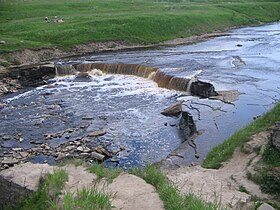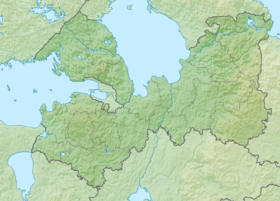The Sablinsky natural monument is an ensemble of natural and historical sites in the Tosno district of the Leningrad region .
| Sablinsky natural monument | |
|---|---|
 Waterfall on the Tosna River | |
| IUCN Category III ( Natural Monument ) | |
| basic information | |
| Area | 328.8 ha [1] |
| Established | March 29, 1976 |
| Location | |
| A country |
|
| The subject of the Russian Federation | Leningrad region |
| Nearest town | Nikolskoye |
Content
- 1 General
- 2 Waterfalls
- 3 caves
- 4 fauna
- 5 Gallery
- 6 notes
- 7 Literature
- 8 References
General
Sablinsky natural monument is located near the village of Ulyanovka Tosnensky district of the Leningrad region , 40 km from St. Petersburg . The reserve zone is located on an area of 328.8 hectares and includes two waterfalls , canyons of the Sablinka and Tosna rivers with outcrops of Cambrian and Ordovician rocks, several caves of artificial origin, as well as a number of historical sites: ancient mounds , the parking lot of Alexander Nevsky before the battle with the Swedes , farm "Desert" - the former estate of Count Alexei Konstantinovich Tolstoy .
Waterfalls
- Sablinsky waterfall on the Sablinka river. Its height varies from 2 m to 4 m from year to year, the reason for this is variable water flow, erosion and other factors. Coordinates:
- Tosnensky Waterfall (or Hertovsky) on the Tosna River. Coordinates:
Caves
“Sablinsky caves” [2] are abandoned underground mines for the extraction of quartz sand (Sablinskaya suite of Middle Cambrian) used for the production of glass. Most of the "caves" were created in the period from the second half of the 19th century to the beginning of the 20th century . At that time, the industrial and construction boom began in St. Petersburg, and the capital needed a large amount of glass. During the First World War and the revolutions, the glass industry fell into decay, however, mining sporadically continued until World War II . After the cessation of production, the mines switched to the natural mode, and after some time collapses and flooding began in them, which led to the separation of the single development arrays into unrelated fragments, the formation of blockages and secondary gravitational cavities, which only remotely resemble the shape of the initial drifts. The resulting labyrinths are quite complex, and their passage requires some preparation and compliance with safety regulations.
In Sablino there are 4 large caves: Left-bank ("Trash"), "Pearl", "Pants", "Rope" and several small caves: "Three-eyed", "Beach", "Dream", "Santa Maria", "Count Grotto ”,“ Fox Holes ”(local names).
Fauna
In the cave "Left-bank" 4 species of night-lights wintered, listed in the Red Book of the Leningrad Region , overwinter — a pond nightlight , Brandt's nightlight (mustachioed), watery nightlight , Natterera's nightlight , as well as a northern leather jacket and brown ushanka , or ordinary. [3] [4]
Waterfalls and caves of the Sablinsky natural monument - the only place in the East European Plain (between Scandinavia and the Caucasus) is the habitat of the largest green-fly fly Liancalus virens in Europe. [5]
Gallery
Sablinsky caves, reconstruction of the life of ancient people
Sablinsky waterfall (river Sablinka)
Cross and stela - a memorial sign at the parking lot of Alexander Nevsky before the battle with the Swedes
Entrance to the Beach Cave
Notes
- ↑ Information on protected areas
- ↑ Sablino is an unknown country. Unique natural monuments of Russia. St. Petersburg: Preservation of nature and cultural heritage, 2007, 200 c.
- ↑ The core of the Naterrera night colony colony in the Left Bank cave of the Sablinsky natural monument. [one]
- ↑ MATERIALS IX annual youth environmental School-Conference in the estate "Sergievka" - a monument of natural and cultural heritage: 2014. "Preservation of the natural environment and the optimization of its use in the Baltic region." [2]
- ↑ On the distribution of Liancalus virens (Scopoli, 1763) (Diptera: Dolichopodidae). Fly Times , 57: 6-10. [3]
Literature
- Sablino is an unknown country. Unique natural monuments of Russia. St. Petersburg: Preservation of nature and cultural heritage, 2007, 200 c.
Links
- “Sablinsky caves: official site”
- “Sablino. Sablinsky caves, Sablinsky waterfalls, museums "
- Sablinsky natural monument on the site "Protected areas of Russia"
- The official website of the regional public organization "Preservation of nature and cultural heritage"
- “Sablino. Sablinsky caves. Underground Portal »

